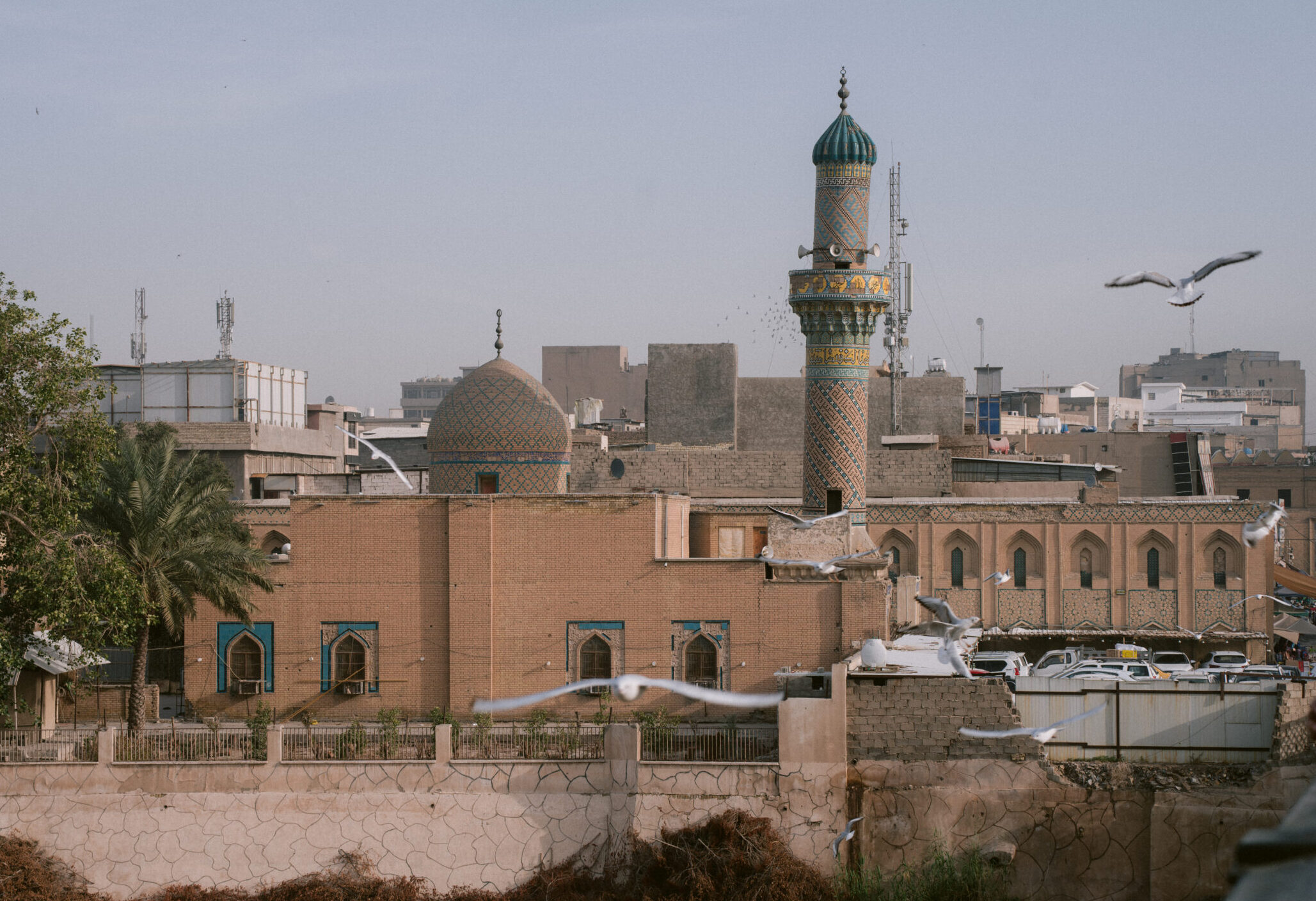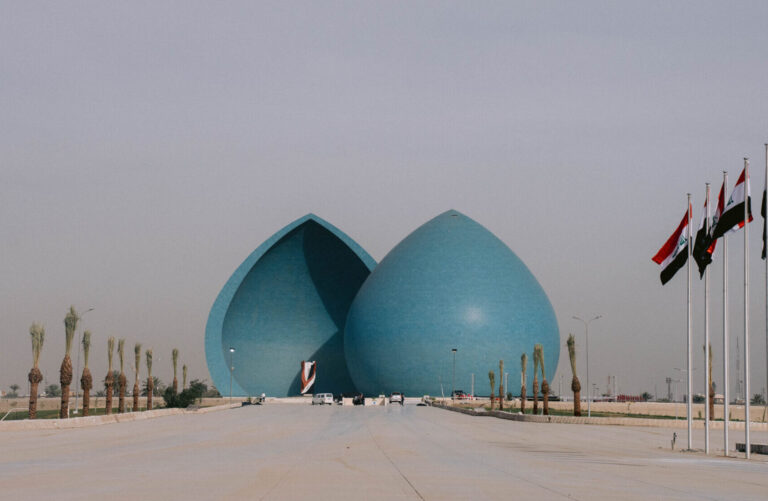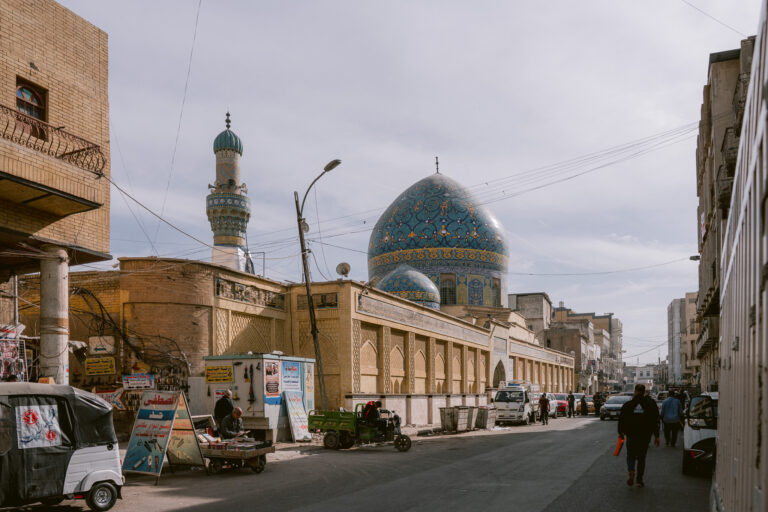10 Incredible Places to Visit in Baghdad, Iraq: From Ancient Streets to Modern Monuments
Think there’s no reason to visit Baghdad, Iraq? Think again. I spent several days in the capital during my 10-day trip through Iraq—and let me tell you, Baghdad is buzzing with life.
Before visiting, everything I’d ever heard about the city focused on war, politics, and yet another missile strike on the news. But once I arrived, I saw a completely different side. Baghdad is full of history, a vibrant literary scene, colorful souks, and pigeons that mysteriously swirl in perfect circles above the skyline (no really, they’re everywhere!).
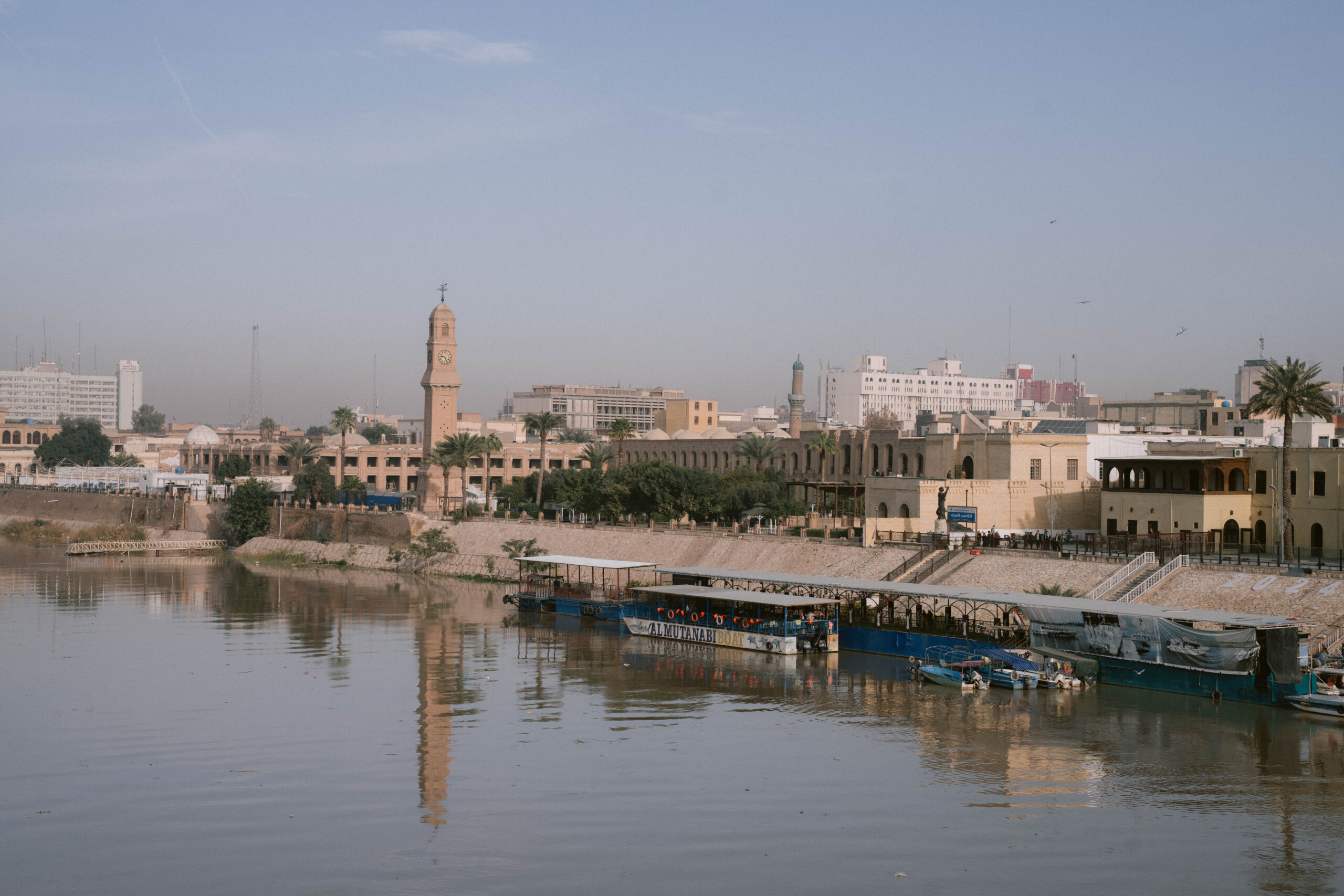
Visiting Baghdad felt like walking through all the history high school forgot to mention. These are the places that shifted my perspective. If you’re weighing safety or entry rules, I talk about that in this post: Can you visit Iraq as a tourist?
From ancient palaces to buzzing markets, this travel guide to Baghdad covers the top things to do, see, and experience in Iraq’s capital city.
🇮🇶 Exploring Baghdad?
Here are some trusted tours for an unforgettable trip:
🚗 Private Baghdad City Tour with a guide and personal driver
🍛 Full-Day Cultural Tour + Lunch Included – history, food, & landmarks
🕌 Walking Tour of Baghdad’s Heritage Sites – mosques, markets, old streets
🏛 Iraqi National Museum Guided Visit – see Mesopotamia’s treasures
10 Places to See in Baghdad
Here are 10 unforgettable places to visit in Baghdad, Iraq—ancient ruins, local markets, and cultural landmarks that will change how you see the city, too.
1. Al-Mutanabbi Street: Baghdad’s Most Famous Book Market
This short street lined with book vendors on both sides is a treat to stroll down. There’s a liveliness in the air—it’s full of locals, and vendors often stop and smile at foreigners. It’s kind of like a flea market for antique hunters and literary nerds, and I loved its slightly chaotic energy.
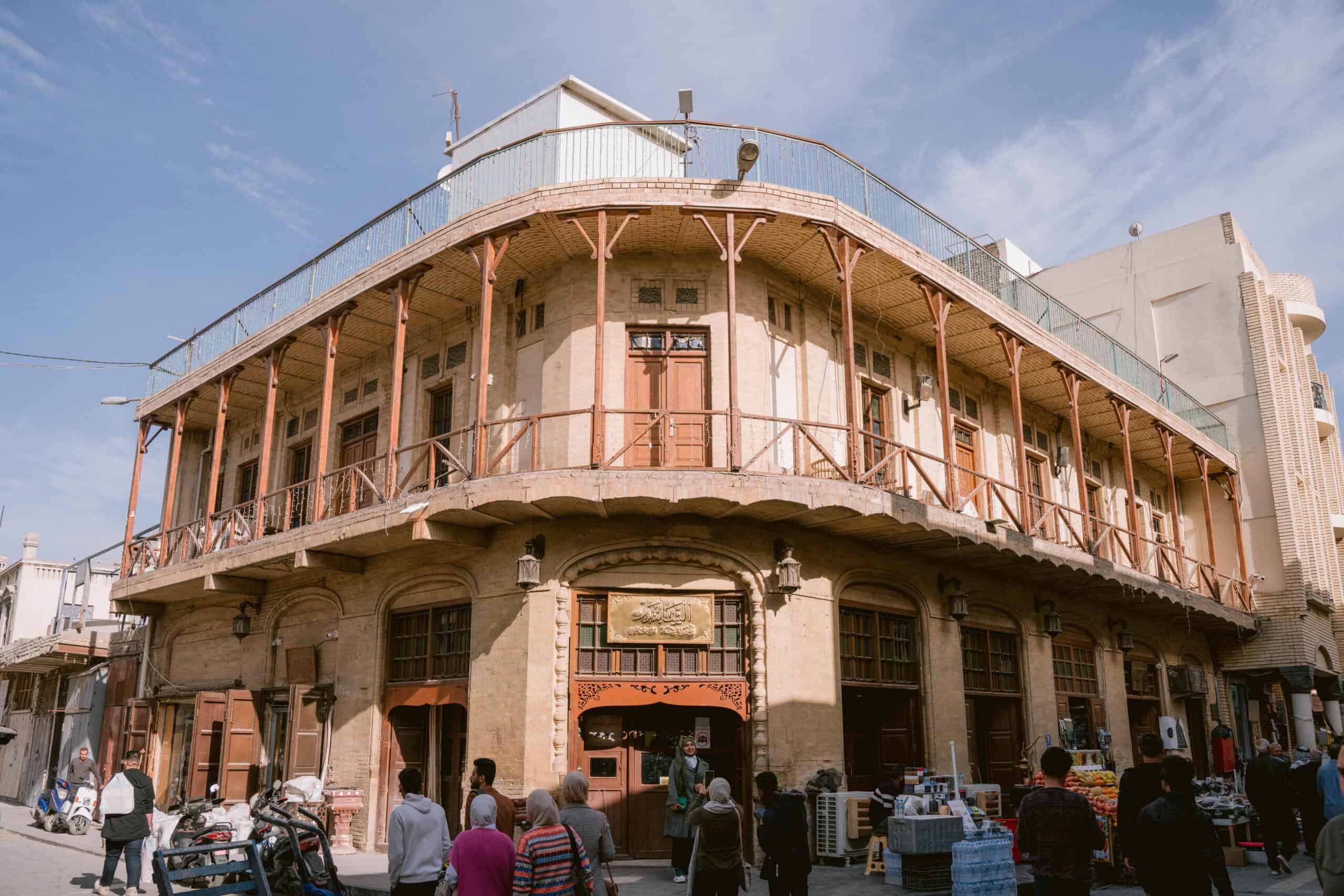
While here, you have to stop for drinks at Café Shabandar, a coffeehouse that’s stood the test of time for over a century. Inside, it feels like stepping back into another era: locals sipping tea or coffee, smoking hookah, and debating politics, culture, art, and literature. The decor is delightfully eclectic—black-and-white photos hang beside bird cages. Side note: between the pigeons flying in circles above Baghdad and the parakeets in cages, I think it’s safe to say Iraqis love their birds.
In March 2007, a car bomb detonated on Al-Mutanabbi Street, killing over 100 people and destroying parts of Café Shabandar. Being in Iraq means confronting its tragic recent history, appreciating the life in it today, and being wowed by its role in civilization’s ancient past. Buckle up.
2. Iraq National Museum: Mesopotamian Artifacts That Have Survived Looting
You might have heard that Iraq is the Cradle of Civilization. The Iraqi National Museum is where you can see it.
The Iraq National Museum in Baghdad is home to artifacts from Sumer, Akkad, Babylon, Assyria—names you may only vaguely recall from high school world history class.
The ancientness (is that a word?) of this museum and the fact that it’s full of artifacts from this region, places it squarely at the top of any must-see list for Baghdad. Humanity’s history is here, y’all!

I saw impressive stonework and carvings from some of the first civilizations as well as 4,000 year old tablets with cuneiform. I also learned about the contributions to physics, mathematics, engineering, astronomy, medicine, and ophthalmology that came straight out of this part of the world. Seriously, why is this not more well-known?
That said, the museum has been through hell. After the 2003 U.S. invasion, it was badly looted. Thousands of priceless artifacts were stolen or destroyed, and many still haven’t been recovered. Some made their way into private collections or…Western museums that still haven’t given them back. I wish I could say this museum was the only victim of looting during the U.S. invasion, but it’s not. And yet, somehow Iraqis are still so welcoming of American tourists.
3. Al-Shaheed Monument: Futuristic & Symbolic
If you’re after the landmarks of a destination that commonly grace postcards, you’ll want to head to Al-Shaheed Monument (Martyrs Monument). I mean, did you even go to Iraq if you don’t have a photo in front of the two giant halves of the blue dome?
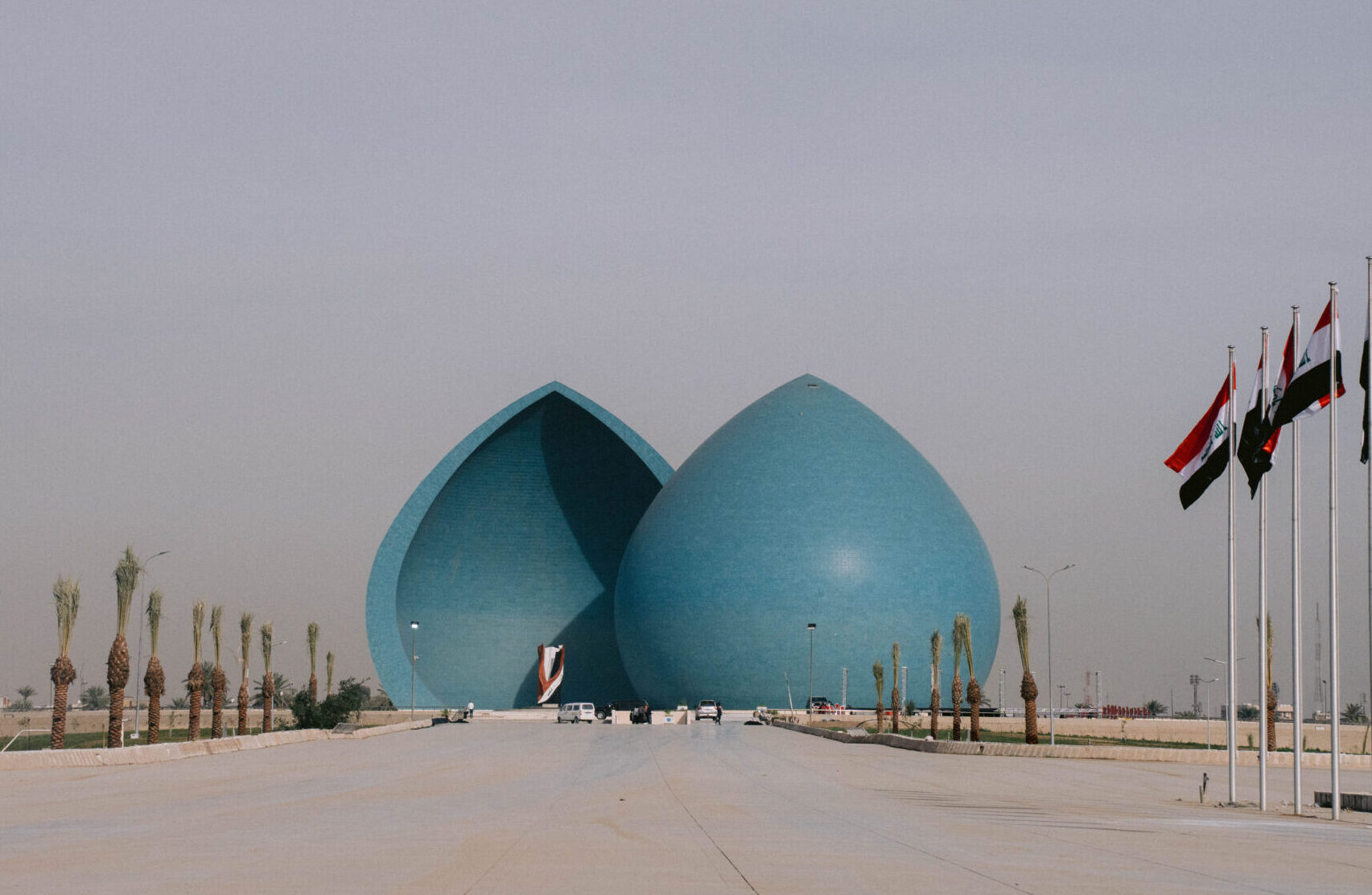
Al-Shaheed Monument was built in the 1980s as a tribute to the martyrs in the Iran-Iraq War, but today it honors all the fallen Iraqis in war. I’ve seen a lot of monuments honoring the fallen in wars on my travels, but this is the only one with a turquoise dome (it’s giving modernist masterpiece, no?). It’s like a reminder of all the wars Iraqis have had to endure and a symbol of Iraq’s modern identity.
When I went, this site was closed for renovation but otherwise, it’s part of a giant park. My guide said that locals typically bring their families to hang at the park so it must be a great spot for people watching, too.
4. Abbasid Palace: A Glimpse into Baghdad’s Golden Age
Overlooking the Tigris, this 12th century brick palace is one of the few surviving structures from the Abbasid Caliphate. It is a remnant and reminder of the time Baghdad was the intellectual and cultural capital of the Islamic world.
You won’t find flashy signs or long lines here. In fact, it’s so low-key that I nearly walked right past the entrance (oops).
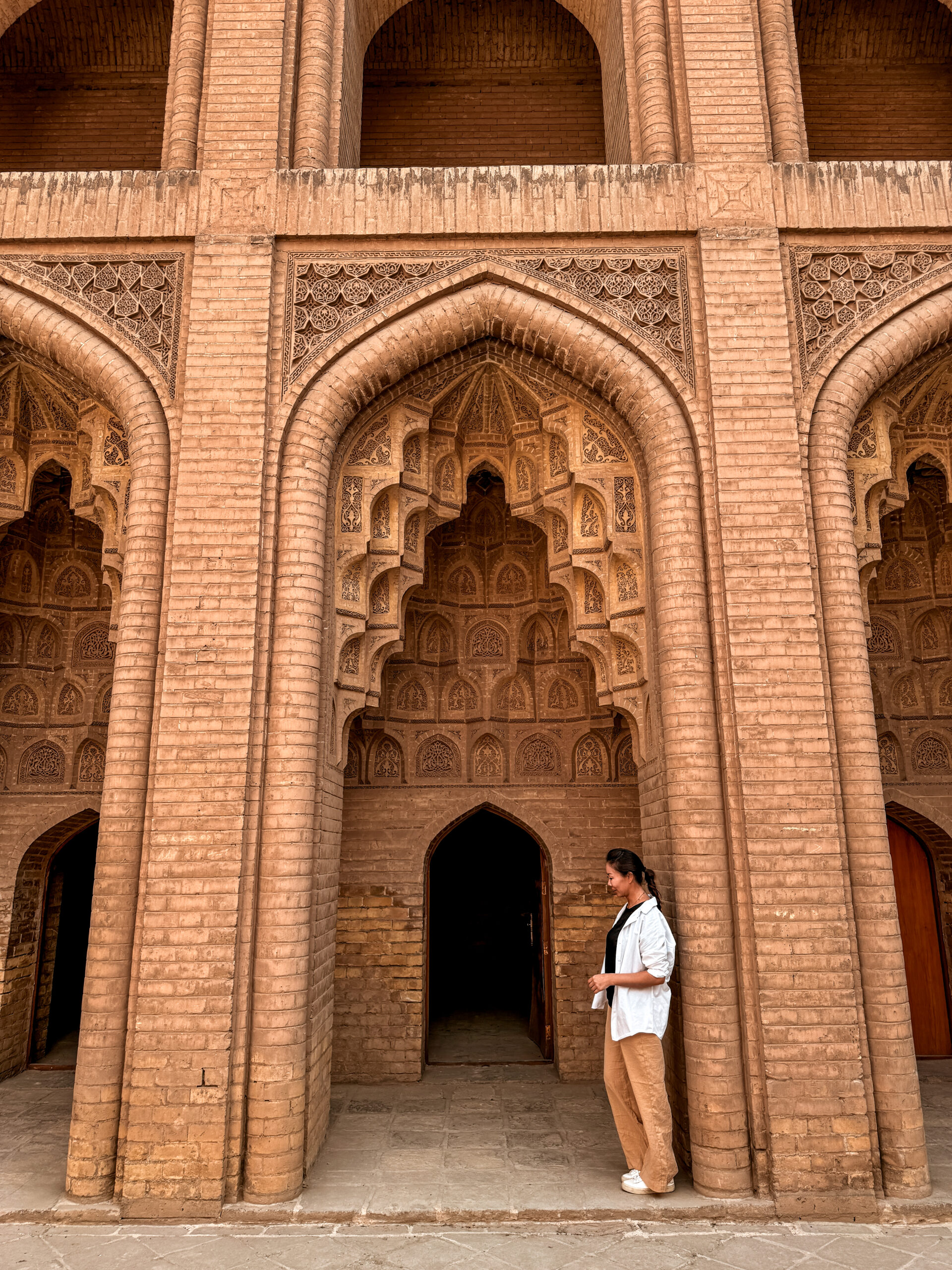
Inside the palace, however, is a different story. The palace was built over 800 years ago and yet, it still has a timeless elegance today. I was taken by the intricate brickwork, geometric patterns, beautiful archways, and the tranquility of the courtyard. It’s a sharp contrast to the hustle and bustle on Baghdad’s streets.
5. Taq Kasra (Arch of Ctesiphon): An Arch That Defies Gravity
I saw photos of Taq Kasra and immediately knew I had to see it in person. It’s colossal, palatial, ancient, and yet, still intact. I knew I had to squeeze it into my Iraq itinerary. I was intrigued.
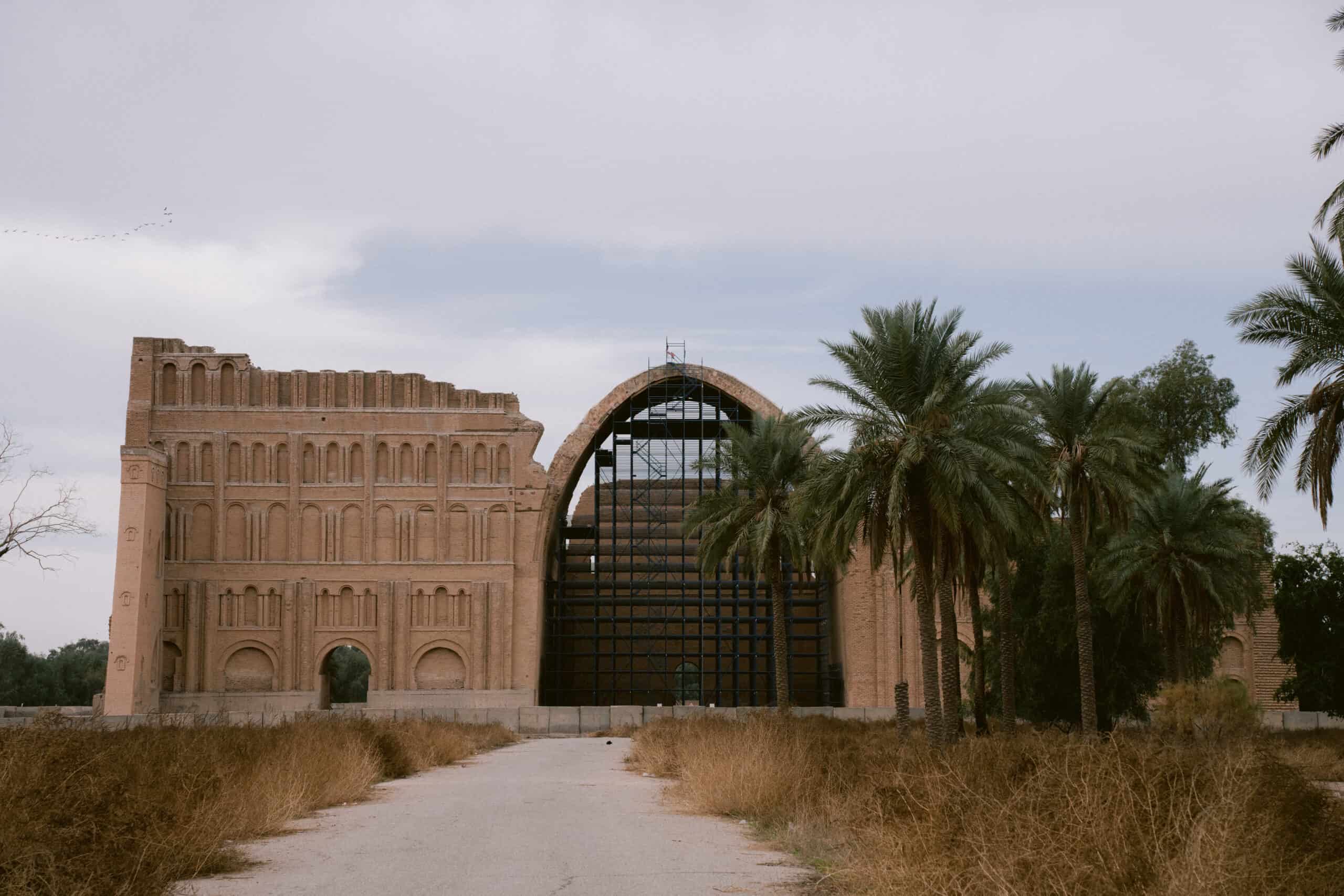
Taq Kasra is located about 45 minutes outside of Baghdad and is the last remaining Persian monument from the Sasanian-era. It dates back to the 3rd to 6th centuries, and the arch is over 1,400 years old. It’s the second largest single-span vault of unreinforced brickwork in the world—and it was built without modern machines.
When I visited, it was under renovation so I couldn’t walk up to it. But, it was still impressive to see in person. It’s also evidence that visiting less-touristed destinations are wildly rewarding because how is this not on the UNESCO world heritage list?
🚗 How do you get to Taq Kasra from Baghdad?
If you’re traveling independently, ask your hotel to help you hire a private driver or taxi to take you there. Otherwise, ask your Iraq tour guide to include this in your tour.
6. Mustansiriya Madrasa: A Powerhouse of Knowledge
If you want proof that Baghdad’s ill-deserving of its conflict-ridden headlines, a visit to Mustansiriya Madrasa should make the list of things to do.
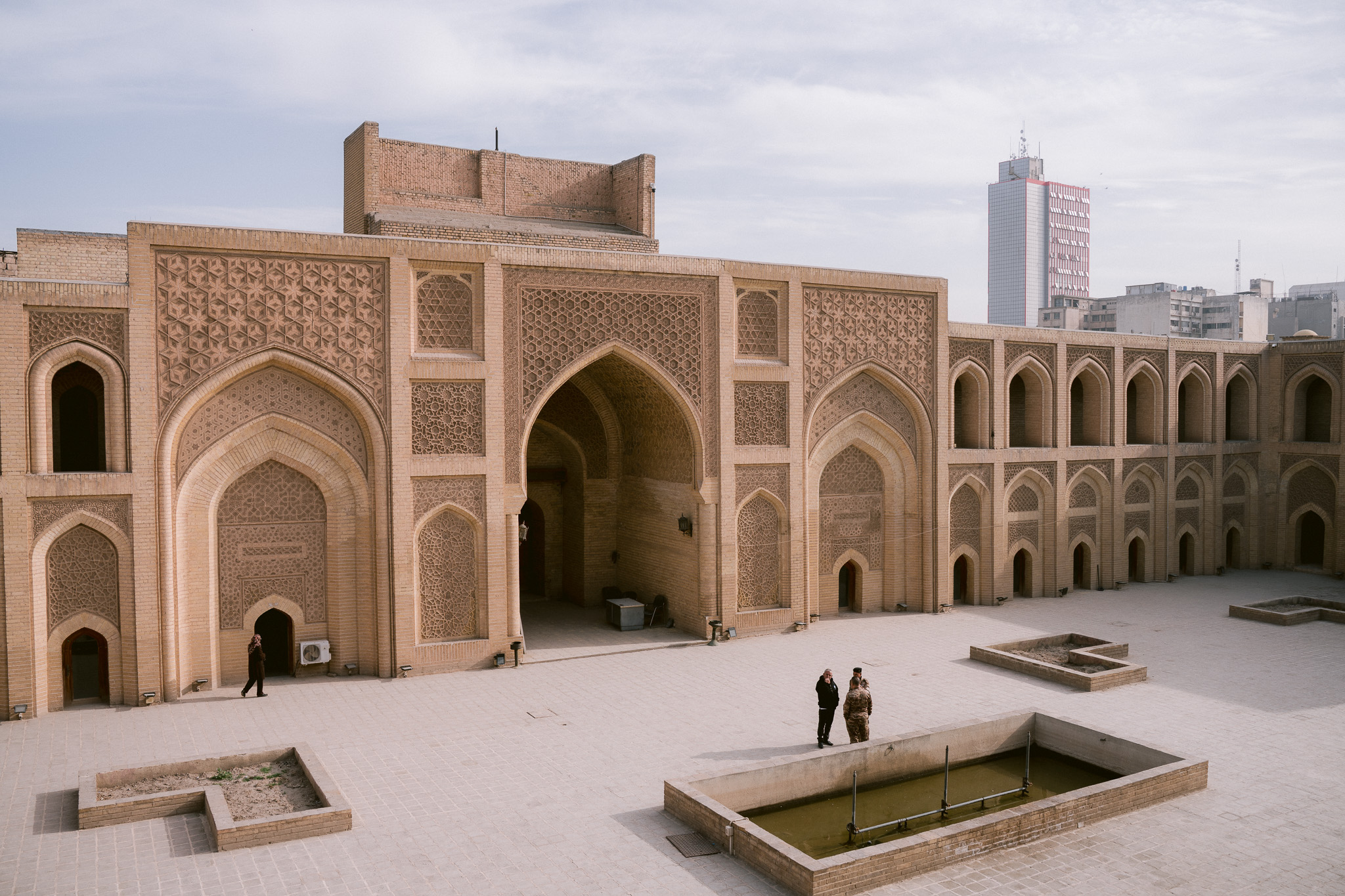
This is one of the oldest universities in the Islamic world and one of the only surviving landmarks from Abbasid Baghdad. Built in the 13th century and still operating today, Mustansiriya Madrasa was one of the premier institutions for students to study Quranic sciences, math, medicine, law, and philosophy. A visit here really highlights how Baghdad was the global center of knowledge for so long.

When I went, I was blown away by the geometric brickwork and simple but stunning architecture. While the university isn’t flashy, it manages to offer a simple and elegant backdrop for students to focus on learning (and for tourists to take photos).
7. Souq al-Saray & Souq al-Safafeer: Artisans, Books, and Chaos
I feel like you can’t go to a new city and not explore its markets. The local market is where you feel the vibe of the city, mix with the locals, and see, hear, touch, and smell the grittiness of a place. This is a rule I follow no matter where I travel and Baghdad is no exception. This is why Souq al-Saray deserves a spot on the list of places to see in Baghdad!
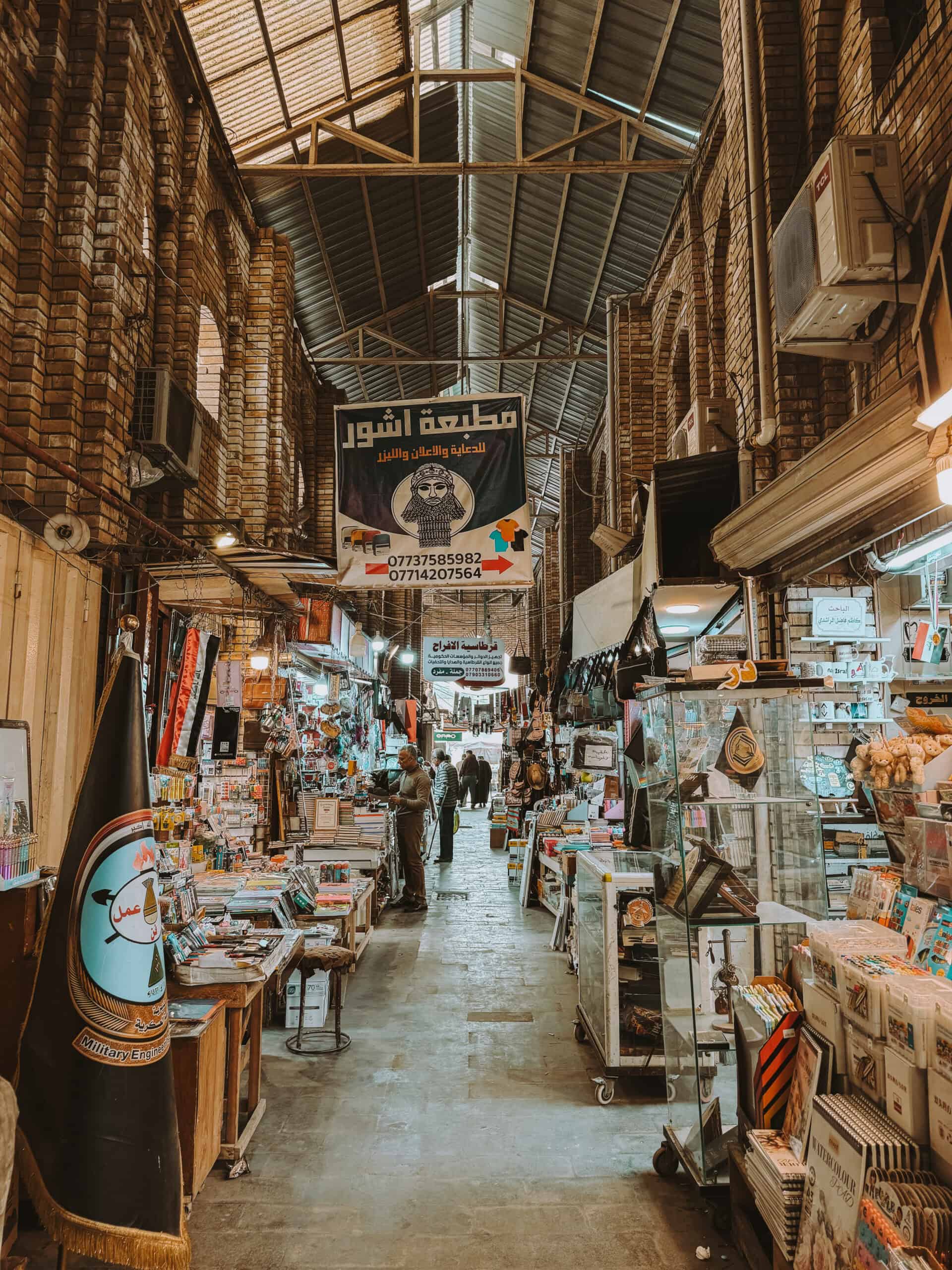
The souq is a visual feast of knick-knacks: antiques, old books, decorative posters, copper goods, and all kinds of randomness you didn’t know you needed. It’s also a good place to pick up souvenirs!
If you want to see coppersmiths in action, head to a side street of Al-Rashid Street and look for Souq al-Safafeer, the copper market. Fair warning—the market isn’t as big as it used to be, but it is still a blast to walk through and soak up the commotion.
Even if you’re not buying anything, this is a solid spot to wander and photograph. My only regret is I didn’t linger longer!
8. Firdos Square: The Moment Everyone Saw But Few Visit
Do you remember the news clip of U.S. forces toppling the Saddam Hussein statue in 2003? Something about that visual stuck. It portrayed the symbolic fall of a dictator—the end of Saddam’s 24-year rule.
Clearly, that media clip struck a chord because it was not only poignant for Americans, but Iraqis, too. My Iraqi guide pointed out exactly where it happened: Firdos Square.
Today, it’s a encircled by a roundabout and the nonstop rush of traffic, which means it’s not the most pedestrian-friendly place to visit in Baghdad. Still, it’s interesting to visit and see how the square and life has moved on. It’s also interesting just to see in person from where this spectacle was broadcast.
9. Al-Rashid Street: Baghdad’s Once Glamorous Street
I’ll be honest—strolling down Al-Rashid street, I would not have known it used to be the most glam street in Baghdad. Today, it’s visibly worn and it’s questionable how some buildings are still standing.
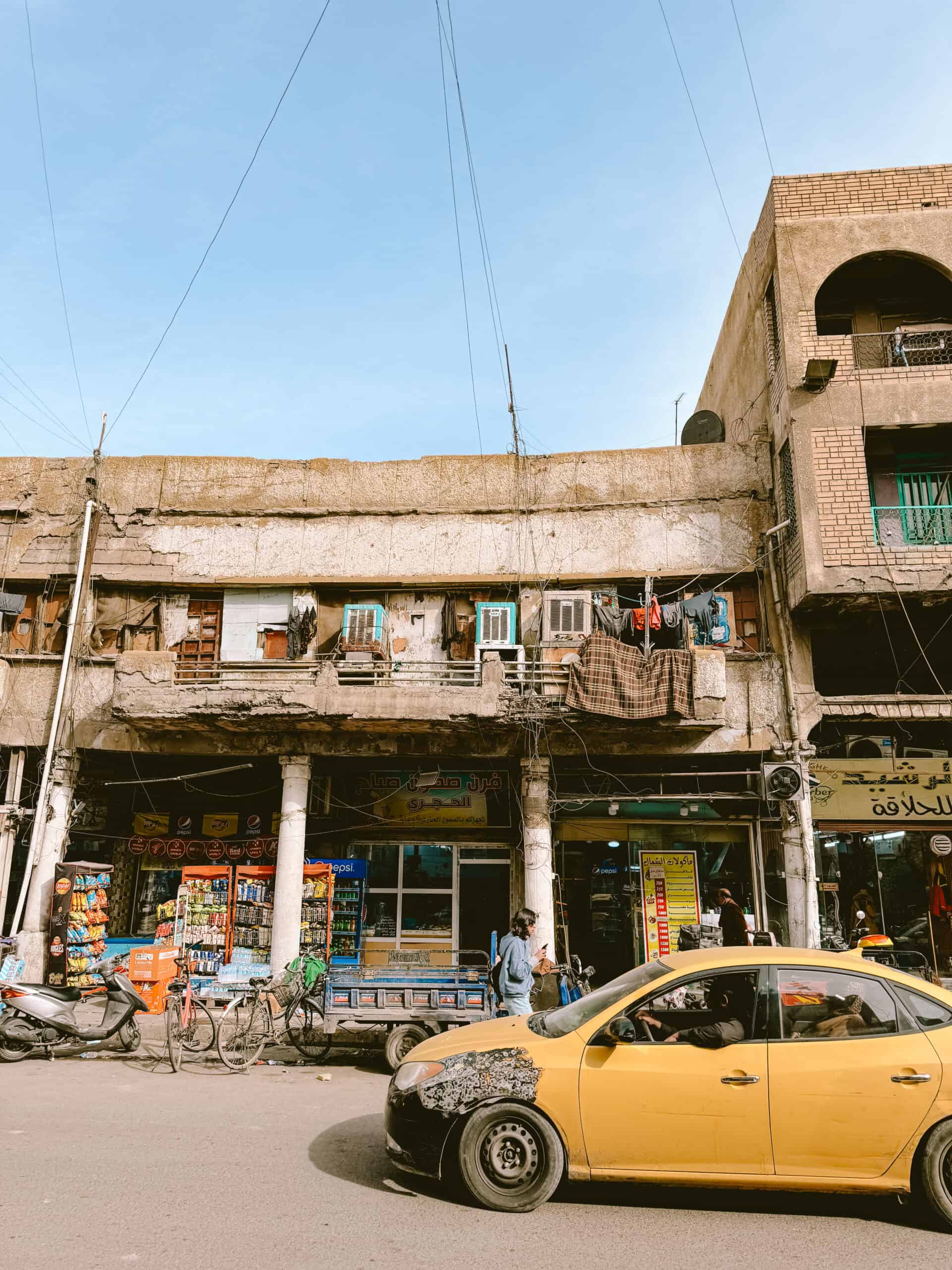
But, it’s still a buzzing street with little market stalls, juice vendors, yellow taxis, and too many electrical wires somehow giving life to it all. The street is still very much alive and for that reason, you should check it out.
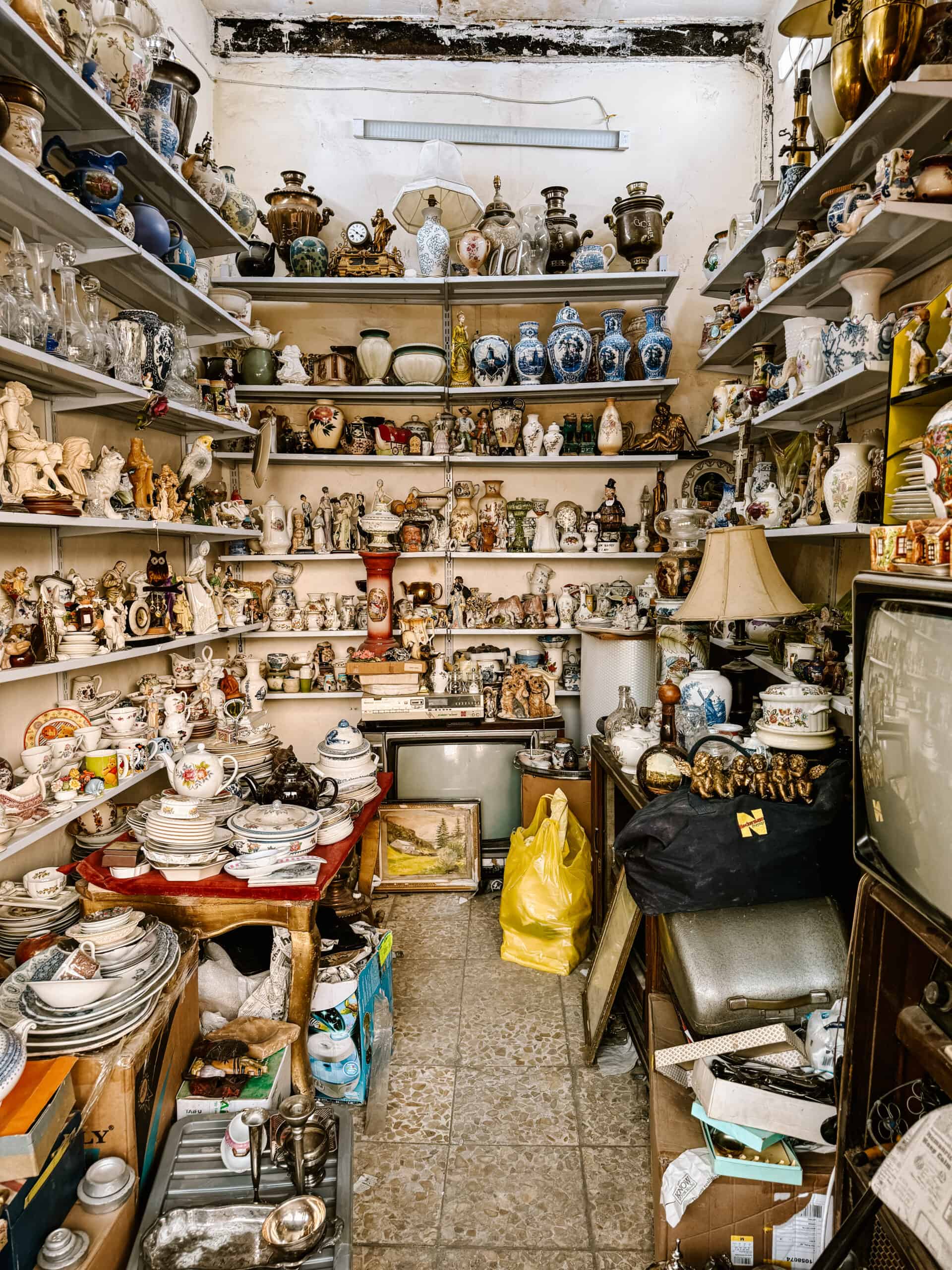
Plus, there’s also a small raisin juice stall on Al-Rashid Street that every prominent Iraqi leader and other world leaders have stopped in: Haji Zbala Juice Store. Inside, you’ll find photos of past leaders who have frequented this shop from Saddam Hussein to Yasser Arafat to Muammar Gaddafi. It also has really good raisin juice!
When I stood here, sipping my raisin juice (in case you’re wondering, it does not taste like grape juice), a random Iraqi with a huge smile came up to me speaking mandarin. He was so excited to find someone to practice his skills. Never in a million years would I have thought I’d be in Baghdad chopping it up with an Iraqi in mandarin, but Iraq is full of surprises.
10. Al-Kadhimiya Shrine: Baghdad’s Spiritual Core
I didn’t make it to Al-Kadhimiya Shrine in Baghdad since I visited others in Karbala and Najaf. But, if you’re only spending time in Baghdad, add this shrine to your list of places to see in Baghdad because Iraqi shrines are simply stunning.
Al-Kadhimiya Shrine is one of the holiest Shia sites and the burial sites of two Shia Imams: Musa al-Kadhim and Muhammad al-Jawad.
As with other shrines in the country, make sure you’re dressed conservatively when visiting and respectful inside. If the shrines in Karbala and Najaf taught me anything, it’s how much reverence one feels in these sacred places.
⭐ Can foreigners visit Al-Kadhimiya Shrine?
Yes, non-muslims are welcome to visit.
🇮🇶 Exploring Baghdad?
Here are some trusted tours for an unforgettable trip:
🚗 Private Baghdad City Tour with a guide and personal driver
🍛 Full-Day Cultural Tour + Lunch Included – history, food, & landmarks
🕌 Walking Tour of Baghdad’s Heritage Sites – mosques, markets, old streets
🏛 Iraqi National Museum Guided Visit – see Mesopotamia’s treasures
Frequently Asked Questions About Visiting Baghdad: safety, how long to visit, where to stay, and more
Yes, it is. I hope sharing these 10 places to visit in Baghdad stirred your wanderlust and opened your eyes to the incredible history and culture this city holds. Baghdad is unlike any other capital. It offers a window into stories you may have only read about in textbooks paired with some of the warmest hospitality you’ll ever experience. Go. You won’t regret it.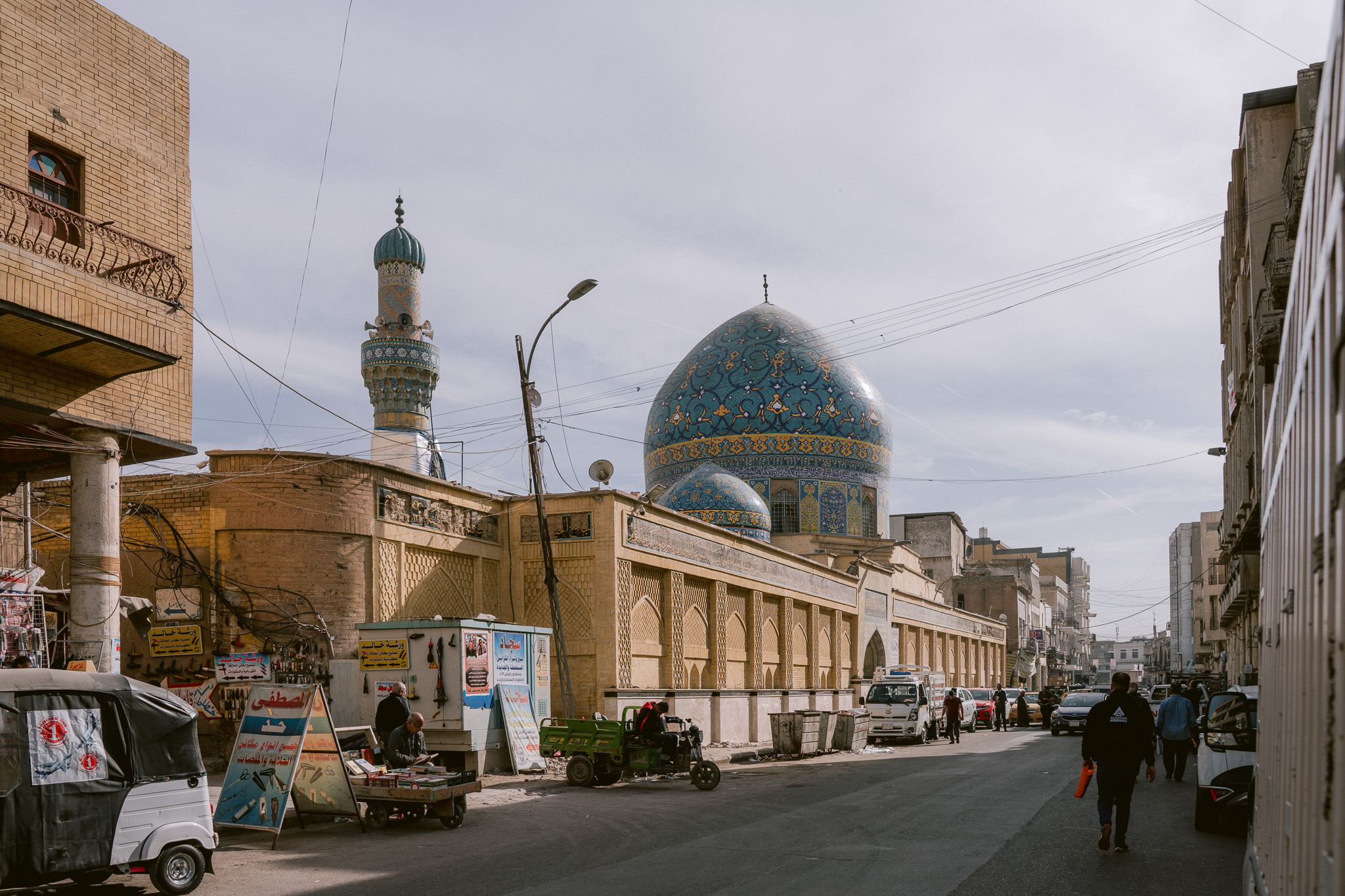
Baghdad itself feels very safe. There are no vendors hustling you, people keep to themselves, and the most that might happen is a stranger coming up to ask for a photo—that’s about it.
That said, I’d be remiss if I didn’t mention that the region flares up every now and then. If you plan a trip here, keep an eye on the news and make your decision based on current tensions.
Still, is anything going to happen to you in Baghdad even if tensions are heightened? Super slim chance. To find out why, read my in-depth thoughts on how safe it is to travel to Iraq in this post.
Plan for 2–3 days to see the city. That gives you time to explore at a relaxed pace, soak it all in, and take a day trip out to Taq Kasra. That said, I recommend a full 10 days for all of Iraq especially if you’re already in Baghdad!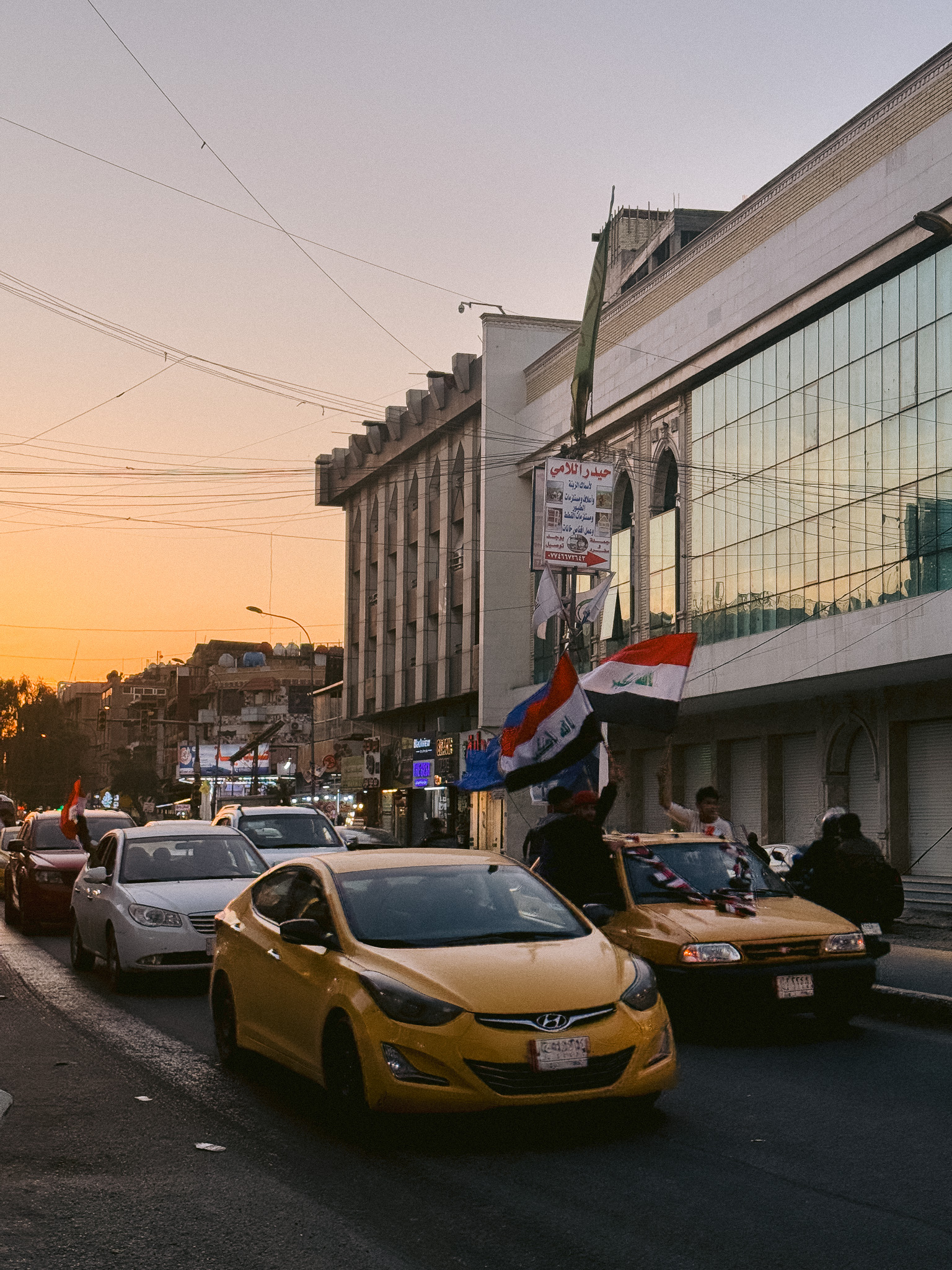
Mid-range: Shanasheel Palace Hotel – This is where I stayed. It’s in a quiet part of town and offers no-frills comfort, friendly service, A/C, and a heater.
High-end: Babylon Rotana – Located along the Tigris River, this is Baghdad’s well-known “5-star” option. Stay here if you’re after the best the city offers while still being close to the action.
The turquoise domes of Al-Shaheed Monument (Martyrs Monument) is the icon of the city.

